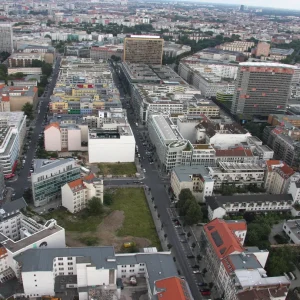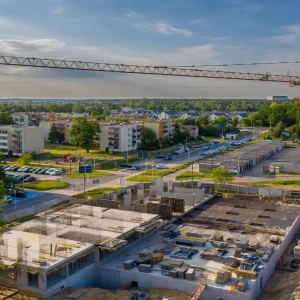
The frequency and intensity of extreme weather events have escalated dramatically over the past few decades. Phenomena such as hurricanes, floods, heatwaves, and severe storms are not just causing immediate destruction but are also forcing cities worldwide to rethink and re-strategise urban policy, planning, and transportation systems. The repercussions of these events are vast, influencing economic stability, public health, infrastructure resilience, and the overall sustainability of urban environments. This article delves into how extreme weather events are reshaping urban policy and planning, the integration of climate adaptation strategies, and the evolution of transportation systems to mitigate the impacts of such adversities.
The Growing Threat of Extreme Weather Events
The Science Behind Increasing Extremes
Climate scientists have attributed the rise in extreme weather events to global climate change. The Intergovernmental Panel on Climate Change (IPCC) reports that human-induced warming is a primary driver behind the increased frequency and severity of extreme weather. Warmer temperatures result in more intense storms, prolonged droughts, and unpredictable weather patterns, all of which pose significant challenges to urban areas.
Economic and Social Impacts
Extreme weather events can have devastating economic and social consequences. The economic costs of natural disasters are immense, with infrastructure damage, business disruptions, and the high cost of recovery and rebuilding. For instance, Hurricane Sandy, which struck the United States in 2012, caused an estimated $70 billion in damages. Socially, these events often displace populations, exacerbate inequalities, and strain public health systems.
Urban Policy and Planning: Adapting to New Realities
Urban policymakers are increasingly prioritising resilience in their agendas. Resilience refers to the capacity of urban systems to withstand and recover from extreme weather events. This involves not only physical infrastructure but also the social and economic dimensions of cities. Key policy initiatives include enhancing building codes, investing in green infrastructure, and developing emergency preparedness plans.
Enhancing Building Codes
Modernising building codes to ensure structures can withstand extreme weather is a critical step. This includes designing buildings to resist high winds, implementing flood-proofing techniques, and using materials that can endure extreme temperatures. For example, Miami-Dade County in Florida has some of the strictest building codes in the United States, a response to the devastation caused by Hurricane Andrew in 1992.
Green Infrastructure
Green infrastructure, such as parks, green roofs, and urban forests, plays a crucial role in mitigating the impacts of extreme weather. These solutions not only help manage stormwater and reduce urban heat islands but also enhance the overall quality of urban life. Cities like Copenhagen and Singapore are leading the way with innovative green infrastructure projects that serve both environmental and recreational purposes.
Emergency Preparedness Plans
Comprehensive emergency preparedness plans are essential for ensuring swift and effective responses to extreme weather events. These plans typically include early warning systems, evacuation protocols, and strategies for maintaining essential services during crises. The city of Tokyo, for instance, has a well-developed disaster preparedness plan that incorporates extensive public education and regular drills.
Integrating Climate Adaptation Strategies
Climate adaptation strategies are increasingly being integrated into urban planning processes. These strategies aim to make cities more resilient to the impacts of climate change through a combination of structural and non-structural measures.
Structural Measures
Structural measures involve the physical modification of urban environments to reduce vulnerability to extreme weather. Examples include constructing sea walls, elevating critical infrastructure, and redesigning drainage systems to handle increased rainfall. The Netherlands is renowned for its sophisticated flood management systems, including the Maeslantkering storm surge barrier, which protects Rotterdam from North Sea storms.
Non-Structural Measures
Non-structural measures focus on policy and behavioural changes that enhance resilience. These include land-use planning, zoning regulations, and public education campaigns. For instance, New York City’s “OneNYC” plan incorporates climate resilience into all aspects of urban planning, from transportation to housing, ensuring that future developments are prepared for the challenges posed by climate change.
Transportation: Building Resilient Networks
Extreme weather events pose significant challenges to urban transportation systems. Flooding, heatwaves, and snowstorms can disrupt public transit, damage infrastructure, and create hazardous conditions for commuters. Ensuring the resilience of transportation networks is crucial for maintaining urban mobility and economic activity.
Flooding
Flooding is one of the most common and destructive impacts of extreme weather on transportation. It can submerge roads, damage rail lines, and disrupt bus and subway services. Cities like London and Paris have invested heavily in flood defences, such as the Thames Barrier and the Seine River flood control systems, to protect their transportation networks from rising water levels.
Heatwaves
Heatwaves can cause significant damage to transportation infrastructure, such as the buckling of roads and rail tracks. They also pose health risks to commuters, particularly in cities with extensive outdoor transit systems. Cities are responding by incorporating heat-resilient materials in infrastructure projects and enhancing air conditioning in public transport vehicles and stations.
Snowstorms
Snowstorms can paralyse urban transportation systems, making roads impassable and causing delays or cancellations of public transit services. Cities in colder climates, such as Toronto and Helsinki, have developed comprehensive snow removal and road maintenance programmes to ensure that transportation networks remain operational during severe winter weather.
Innovations in Transportation Resilience
To address these challenges, cities are adopting innovative approaches to enhance the resilience of their transportation systems.
Smart Transportation Systems
Smart transportation systems leverage technology to improve the efficiency and resilience of urban mobility. This includes real-time monitoring of weather conditions, predictive analytics to anticipate disruptions, and adaptive traffic management systems. Singapore’s Intelligent Transport System is a prime example, utilising sensors and data analytics to optimise traffic flow and respond swiftly to weather-related disruptions.
Multi-Modal Transportation
Promoting multi-modal transportation options can enhance resilience by providing alternative means of travel during extreme weather events. This involves integrating various modes of transport, such as buses, trains, bicycles, and walking paths, into a cohesive network. Amsterdam is a leading example, with a robust multi-modal system that includes extensive cycling infrastructure and efficient public transit.
Sustainable and Resilient Infrastructure
Investing in sustainable and resilient transportation infrastructure is crucial for mitigating the impacts of extreme weather. This includes constructing durable roads and bridges, implementing permeable pavements to manage stormwater, and developing electric vehicle charging networks to reduce greenhouse gas emissions. The city of Oslo is pioneering efforts in this area, with ambitious plans to electrify its public transport fleet and enhance infrastructure resilience.
Case Studies: Leading Cities in Climate Resilience
Copenhagen: Pioneering Urban Resilience
Copenhagen is widely regarded as a leader in urban resilience, particularly in its approach to managing extreme weather. The city’s Climate Adaptation Plan includes innovative solutions such as cloudburst boulevards, which are designed to channel excess rainwater away from vulnerable areas. Copenhagen’s commitment to green infrastructure and sustainable urban development serves as a model for other cities aiming to enhance their resilience.
Rotterdam: The Flood-Proof City
Rotterdam’s proactive approach to flood management has earned it a reputation as one of the most resilient cities in the world. The city’s comprehensive flood defence system includes storm surge barriers, dikes, and innovative water plazas that temporarily store excess rainwater. Rotterdam’s strategy of living with water rather than fighting it provides valuable lessons for cities facing similar challenges.
Singapore: Smart and Resilient
Singapore’s emphasis on smart technology and innovative urban planning has made it a global leader in resilience. The city-state’s Intelligent Transport System and Smart Nation initiative integrate data analytics, real-time monitoring, and adaptive infrastructure to enhance urban resilience. Singapore’s holistic approach to resilience, encompassing technology, infrastructure, and community engagement, offers a blueprint for other cities to follow.
Conclusion
The increasing frequency and severity of extreme weather events necessitate a fundamental rethinking of urban policy, planning, and transportation systems. Cities must prioritise resilience, integrate climate adaptation strategies, and invest in innovative transportation solutions to mitigate the impacts of these events. By learning from leading cities and adopting best practices, urban areas can enhance their resilience and ensure a sustainable and secure future in the face of climate change. The challenges are significant, but with proactive planning and a commitment to innovation, cities can turn the threat of extreme weather into an opportunity for transformation and growth.






